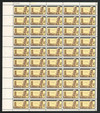
1962 4c Dag Hammarskjold
# 1203 - 1962 4c Dag Hammarskjold
$0.35 - $18.50
U.S. #1203
1962 4¢ Dag Hammarskjold
Issue Date: October 23, 1962
City: New York, New York
Quantity: 121,440,000
Printed By: Bureau of Engraving and Printing
Printing Method: Giori Press
Perforations: 11
Color: Black, brown and yellow
U.S. #1203 was issued in honor of United Nations Secretary-General Dag Hammarskjold, who had died in a plane crash a year earlier. Hammarskjold (1905-61), of Sweden, was the second Secretary-General of the U.N., and the only person to be awarded the Nobel Peace Prize after his death. U.S. President John F. Kennedy called Hammarskjold the greatest statesman of our century.
This stamp is also notable for an invert error that occurred, which caused the yellow background to be inverted most obviously with a white shadow next to the United Nations building in the design. The error led the postmaster general to authorize a special printing, resulting in U.S. #1204.
U.S. #1203
1962 4¢ Dag Hammarskjold
Issue Date: October 23, 1962
City: New York, New York
Quantity: 121,440,000
Printed By: Bureau of Engraving and Printing
Printing Method: Giori Press
Perforations: 11
Color: Black, brown and yellow
U.S. #1203 was issued in honor of United Nations Secretary-General Dag Hammarskjold, who had died in a plane crash a year earlier. Hammarskjold (1905-61), of Sweden, was the second Secretary-General of the U.N., and the only person to be awarded the Nobel Peace Prize after his death. U.S. President John F. Kennedy called Hammarskjold the greatest statesman of our century.
This stamp is also notable for an invert error that occurred, which caused the yellow background to be inverted most obviously with a white shadow next to the United Nations building in the design. The error led the postmaster general to authorize a special printing, resulting in U.S. #1204.












